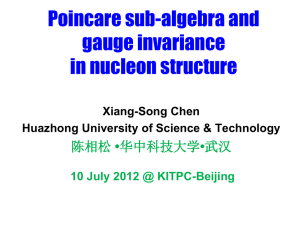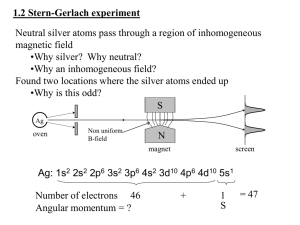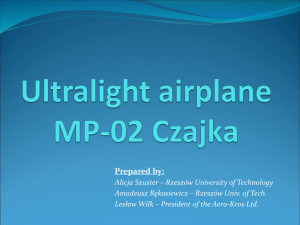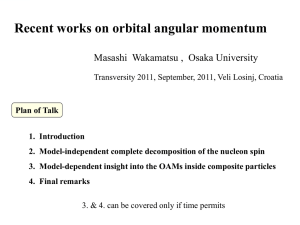ChenXS
advertisement
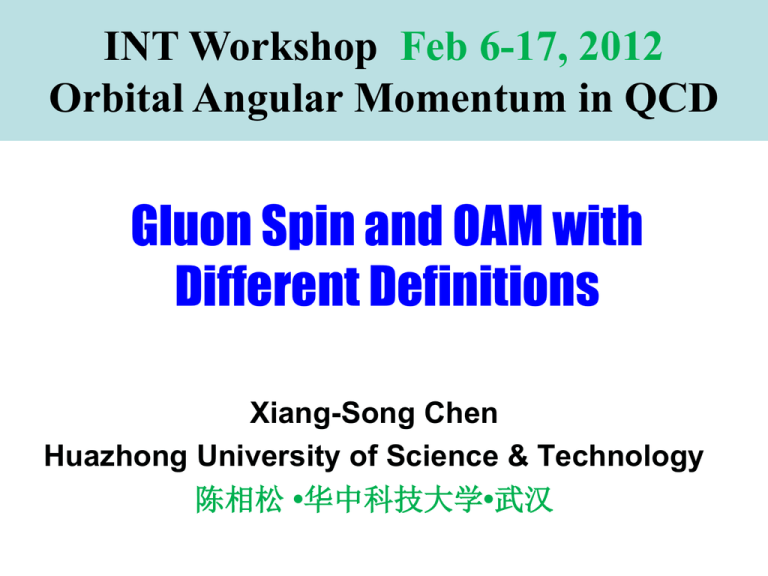
INT Workshop Feb 6-17, 2012 Orbital Angular Momentum in QCD Gluon Spin and OAM with Different Definitions Xiang-Song Chen Huazhong University of Science & Technology 陈相松 •华中科技大学•武汉 A universally correct statement for the nucleon spin Nucleon spin comes from the spin and orbital motion of quarks and gluons --- Chairman Mao Actual practice: Challenge and Controversy Elliot Leader (2011) Jaffe-Manohar [NPB337:509 (1990)] 1 1 J total d 3 x d 3 xx d 3 xE A d 3 xx E iAi 2 i Ji [PRL78:610 (1997)], Chen-Wang [CTP27:212 (1997)] J total d 3 x 1 1 d 3 xx D d 3 xx E B 2 i Gauge Invariance! Chen-Lu-Sun-Wang-Goldman [PRL100:232002 (2008); 103:062001 (2009)] 1 1 i J total d 3 x d 3 xx Dpure d 3 xE Aphys d 3 xx E i Dpure Aphy s 2 i Wakamatsu [PRD81:114010(2010); 83:014012 (2011); 84:037501 (2011)] J total d 3 x 1 1 a d 3 xx D d 3 xE Aphys d 3 xx ( E i D pure Api hys Aphys a) 2 i Outline (of lecture series) I. Chief theoretical framework and key issues (uniqueness, applicability) II. Leader’s criteria of separating momentum and angular momentum III. The issue of convenience and finetuning in actual application IV. Another complementary example: graviton (spin-2 gauge particle) V. Prospect Related recent papers 1) Art of spin decomposition Xiang-Song Chen, Wei-Min Sun, Fan Wang, T. Goldman, Phys. Rev. D 83, 071901(R) (2011). 2) Proper identification of the gluon spin Xiang-Song Chen, Wei-Min Sun, Fan Wang, T. Goldman, Phys. Lett. B 700, 21 (2011). 3) Physical decomposition of the gauge and gravitational fields Xiang-Song Chen, Ben-Chao Zhu, Phys. Rev. D 83, 084006 (2011). 4) Spin and orbital angular momentum of the tensor gauge field. Xiang-Song Chen, Ben-Chao Zhu, Niall Ó Murchadha, arXiv:1105.6300 I. Chief theoretical framework and key issues (uniqueness, applicability) Review of the theoretical efforts Uniqueness of separating a gauge field into physical and pure-gauge components. The prescription for actual application The non-Abelian gluon field Short summary of added contributions (compared to the familiar separation of a vector field) History of theoretical efforts: Brief Review 1988-1996: Dark age, no gauge-invariance 1997-2000: Two approaches towards gauge-invariance: Operator/Matrix Element 2001-2007: Another miserable stage 2008-2010: The field-separation method 2011: Revival of the naïve canonical approach by Elliot Leader 2012: Reconciliation of Leader’s Criteria with gauge-invariance at operator level 1988-1996: Dark age, no gauge-invariance J total 1 3 1 d x d xx d 3 xE A d 3 xE i x Ai 2 i Sq Lq Sg Lg 3 Jaffe-Manohar [NPB337:509 (1990)] Concentration on quark spin, the only gauge-invariant piece, from ~0% to ~30% 1997: Manifestly gauge-invariant decomposition of the nucleon spin 1 1 d 3 xx d 3 xE A d 3 xE i x Ai 2 i Sq Lq Sg Lg 1) J total d 3 x 2) J total Ptotal 1 3 1 d x d xx D d 3 xx E B 2 i Sq L'q J'g 3 1 3 3 1 d x D d xE B d x d 3 xE i Ai i i 3 X. Ji, Phys. Rev. Lett. 78, 610 (1997) X.S. Chen, F. Wang, Commun.Theor. Phys. 27:212 (1997) 1998: A delicate and appealing possibility: gauge-invariant matrix element of gaugedependent operators in certain states J total 1 3 1 d x d xx d 3 xE A d 3 xE i x Ai 2 i Sq Lq Sg Lg 3 Ptotal 1 d x d 3 xE i Ai Pq Pg i L [J z q 3 z total , O], P [P , O '] z q z total X.S. Chen, F. Wang, hep-ph/9802346: a path-integral proof M. Anselmino, A. Efremov, E. Leader, Phys. Rep. 261:1 (1995). Problem with the covariant derivative Electron in a magnetic field ˆ ˆ ˆ 1 1 PK D qA PK PK iq A iqB i i ˆ ˆ ˆ ˆ 1 LK r D LK LK iLK ir [r ( A)] i LK is not quantized, thus does not help to solve/label a quantum state Questioning the path-integral proof of gauge-invariant matrix element for gauge-dependent operators Explicit counter example by perturbative calculation P. Hoodbhoy, X. Ji, W. Lu, PRD 59:074010 (1999); P. Hoodbhoy, X. Ji, PRD 60, 114042 (1999). Questioning the path-integral proof of gauge-invariant matrix element for gauge-dependent operators---continued Revealing the unreliability of the utilized conventional path-integral approach X.S. Chen, W.M. Sun, F. Wang, JPG 25:2021 (1999). W.M. Sun, X.S. Chen, F. Wang, PLB483:299 (2000); PLB 503:430 (2001). The common practices can be wrong: Averaging over the gauge group; Interchange of the integration order The recent proof of Elliot Leader by canonical quantization Limitation to covariant quantization in the covariant gauge! E. Leader, PRD 83:096012 (2011) 2001-2007: Another miserable stage Mixed use of different decompositions! In both theory and experiments! 1) J total 2) J total 1 3 1 d x d xx d 3 xE A d 3 xE i x Ai 2 i Sq Lq Sg Lg 3 1 3 1 d x d xx D d 3 xx E B 2 i Sq L'q J'g 3 A typical confusion: Sg~0, Lg~0, L’q~0, then where is the nucleon spin?! 2008-2010: The field-separation method Key Observation: Dual Role of the Gauge Field eig 1. Conpensate phase freedom of : A A 1 L i igA m F F 4 2. Physical coupling to : Physical decomposition of the gauge field and its dual role Decomposition: A Aphys Apure Aphys and Apure are to be expressed in terms of A A transforms as does A , and gives zero F pure Desired goal: A transform covaria ntly as does F phys A pure solely carries the pure-gauge degrees of freedom Namely: Aphys solely carries the physical degrees of freedom Advantage (usage) of the decomposition Apure is used instead of A to construct covariant derivative or the gauge link Wilson line to achieve gauge invariance Aphys is used instead of F as the canonical variable Physical quantity = f(Aphys, Dpure,…) Application: Consistent separation of nucleon momentum and spin L d 3x r P van Enk, Nienhuis, J. Mod. Opt. 41:963 (1994) Chen, Sun, Lü, Wang, Goldman, PRL 103:062001 (2008) The conventional gauge-invariant “quark” PDF The gauge link (Wilson line) restores gauge invariance, but also brings quark-gluon interaction, as also seen in the moment relation: The modified quark PDF With a second moment: The conventional gluon PDF Relates to the Poynting vector: Gauge-invariant polarized gluon PDF and gauge-invariant gluon spin Its first moment gives the gauge-invariant local operator: j M g ij F i ij Aphys , which is the + component of the gauge-invariant gluon spin S g E Aphys Physical separation of the Abelian Field: Prescription Boundary condition: F | x 0, Aˆ | x 0 Physical separation of the Abelian Field: Solution F | x 0, Aˆ | x 0 Physical separation of the Abelian Field: Uniqueness 1 ˆ ˆ A 0 A ( ) F Initial condition required! Aˆ z 0 Aˆ ( x, y, z, t ) Fz ( x, y, z ', t )dz ' z Aˆ 0 Aˆ ( x, y, , ) F ( x, y, , ')d ' Physically controllable boundary conditions: Vanishing at a finite surface within a certain accuracy Open surfaces: Well-defined mathematically, ill-defined physically!!! Closer look at the distinct behaviors Open boundary: The field persists constantly to infinity Aˆ z 0 Aˆ ( x, y, z, t ) Fz ( x, y, z ', t )dz ' z Separation of non-Abelian field Perturbative solution The explicit expressions Short summary of the contributions added (compared to the familiar separation of a vector field) A four-dimensional formulation including time-component The generalization to non-Abelian field The pure-gauge covariant derivative Clarification on the impossibility of distinct extension II. Leader’s criteria of separating momentum and angular momentum The new controversies and Leader’s compelling criteria Recalling the Poincare algebra and subalgebra for and interacting system Generators for the physical fields: QED The quark-gluon system The new controversy and Leader’s Criteria Jaffe-Manohar [NPB337:509 (1990)] 1 1 J total d 3 x d 3 xx d 3 xE A d 3 xx E i Ai 2 i Chen-Lu-Sun-Wang-Goldman [PRL100:232002 (2008); 103:062001 (2009)] 1 1 i J total d 3 x d 3 xx Dpure d 3 xE Aphys d 3 xx E i Dpure Aphys 2 i Wakamatsu [PRD81:114010(2010); 83:014012 (2011); 84:037501 (2011)] 1 1 i J total d 3 x d 3 xx D d 3 xE Aphys d 3 xx ( E i D pure Aphys Apha ys a ) 2 i Interacting theory: Structure of Poincare generators Lagrangian: L La Lb Lint "Good" generators "bad" generators P Pa Pb H = H a H b H int J J a J b K K a Kb Kint Spatial translation and rotation are kinematic Time translation and Lorentz boost are dynamic Interacting theory: Poincare (sub)algebra [ J i , J (ja ,b ) ] i ijk J (ka ,b ) i j k Kinematic transformation [ J , P( a ,b ) ] i ijk P( a ,b ) [ P i , P j ] 0 ( a ,b ) [ K i , J aj,b ] i ijk K ak,b Dynamic transformation i j [ K , Pa ,b ] iH a ,b ij [ K i , J j ] i ijk K k Only total J and P are covariant: i j [ K , P ] iH ij Generators for the gauge-invariant physical fields - translation Generators for the gauge-invariant physical fields - Rotation The quark-gluon system Generator for the gaugeinvariant quark field Generator for the gaugeinvariant gluon field Some detail in the proof III. The issue of convenience and fine-tuning in actual application Hint from a forgotten practice: Why photon is ignored for atomic spin? The fortune of choosing Coulomb gauge Quantitative differences Fine-tuning for the gluon spin and OAM Hint from a forgotten practice: Why photon is ignored for atomic spin? Do these solution make sense?! The atom as a whole Close look at the photon contribution The static terms! Justification of neglecting photon field A critical gap to be closed The same story with Hamiltonian The fortune of using Coulomb gauge Momentum of a moving atom A stationary electromagnetic field carries no momentum Gauge-invariant revision – Angular Momentum Gauge-invariant revision -Momentum and Hamiltonian The covariant scheme spurious photon angular momentum Gluon angular momentum in the nucleon: Tree-level 3 J ' g d x r ( E B) 0 One-gluon exchange has the same property as one-photon exchange Beyond the static approximation Fine-tuning for the gluon spin and OAM Possible convergence in evolution Another complementary example: graviton (spin-2 gauge particle) The tensor gauge field Canonical expression of spin and OAM Canonical expression of spin and OAM Complete tensor gauge conditions Vanishing of angular momentum for a stationary tensor gauge field No spurious timedependence The same property of momentum Prospect of measuring the new quantities The same experiments as to “measure” the conventional PDFs New factorization formulae and extraction of the new PDFs Quark and gluon orbital angular momentum can in principle be measured through generalized (offforward) PDFs Reminder on the goal of studying nucleon structure • The ultimate goal:A complete description of the nucleon Completeness:sufficiency in predicting all reaction involving nucleon • Intermediate goal: to learn from the nucleon internal dynamics by looking at the origins of mass, momentum, spin, magnetic moment, etc. Possibly a real final solution l=1 m=1 e B LY11 ikr i E B i A k E Flux EB J Flux E A Ei x Ai (rad. gauge) Dipole rad. ikr x EB dP dJ z dJ z d 1 cos d 1 cos d 2 2 2sin 2 Hadron physics is the best subject to educate people --- Chairman Mao
